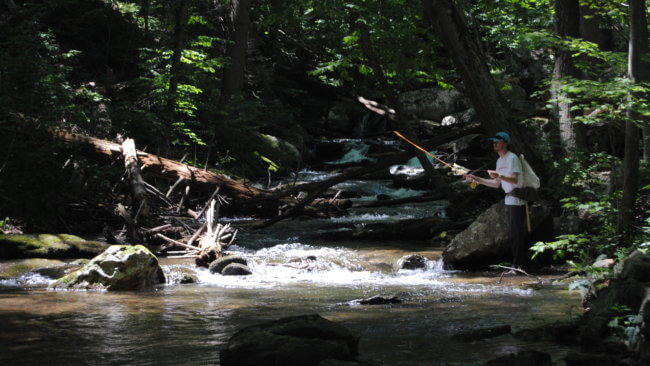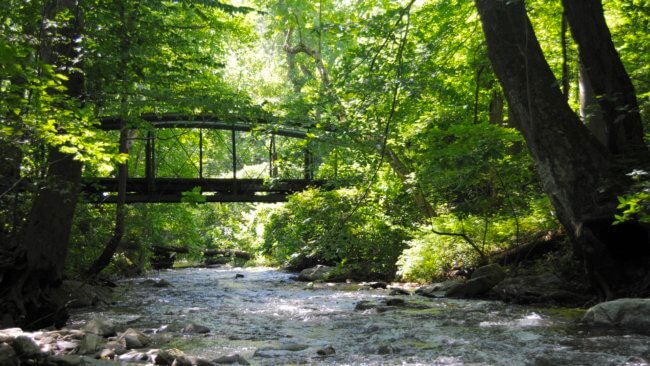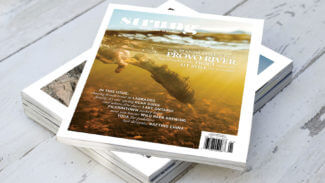Originally Appeared in Strung Volume I, Issue I
By Joe Dahut
I sit on the edge of the trunk to string up my boots, the laces still soggy from yesterday’s adventure. Spring’s recent arrival brings pleasant days warm enough to ditch my waders for shorts. Finally, the brush is overgrown and the hatches are plentiful, the nirvana I have dreamt of since winter. The brook trout streams of Maryland that I call my home water are a splattering of wilderness and a buffet of adventure and discovery. They are wild, untouched land void of trails, signs, or cell phone service, hosting no modern distractions. Brook trout fishing is theological, a transferal of worries and stresses into the simplicity of connecting to a five inch fish with Pollock-esque coloring. Rattlesnakes sleep on mossy rocks by trickling streams so skinny you could spit across them. Brook trout habitats are forms of fine art, and they include as many joys as they do frustrations.
 I am ankle deep in running water, staring down a deeper pool that quite obviously holds fish. Although small, the fish are beautiful and electric – living artifacts of the land, swimming in the cold water mountain streams from Maine to Georgia. I pinch the bushy feathers of an orange stimulator I tied the night prior, a burst of color, a buoyant brook trout snack. My rod tip bends towards me, line taut in precast pressure. My thumb and pointer finger separate and line shoots over the unsuspecting pod of trout. The freezing water sheltered by rhododendron and other shrubs swallows my fly below the surface. After saucing up the wings of my fly with floatant, I shoot another cast to the left of the riffle. The long leader springs and gives me a faulty drift. Sure enough, the trout call my bluff and stay put, eyes upstream, waiting for the real bugs to parade into the feeding zone. Identifying where brook trout live is one thing, catching them is another.
I am ankle deep in running water, staring down a deeper pool that quite obviously holds fish. Although small, the fish are beautiful and electric – living artifacts of the land, swimming in the cold water mountain streams from Maine to Georgia. I pinch the bushy feathers of an orange stimulator I tied the night prior, a burst of color, a buoyant brook trout snack. My rod tip bends towards me, line taut in precast pressure. My thumb and pointer finger separate and line shoots over the unsuspecting pod of trout. The freezing water sheltered by rhododendron and other shrubs swallows my fly below the surface. After saucing up the wings of my fly with floatant, I shoot another cast to the left of the riffle. The long leader springs and gives me a faulty drift. Sure enough, the trout call my bluff and stay put, eyes upstream, waiting for the real bugs to parade into the feeding zone. Identifying where brook trout live is one thing, catching them is another.
Studying the tendencies of brook trout is an unabridged version of casting a fly in small water. Although casting in an attic will grant more space than many of these streams would like to offer, these habitats are precious relics to communities throughout the East Coast. Crouching, kneeling, or clinging onto a tree branch for support are frequent moves in the brook trout angler’s playbook, moves that showcase creativity and stealth, essentials to success.
Fishing for brook trout on the fly conjures a sense of what fly fishing is really about – the small things that initially attracted us to the sport. Dry fly action aplenty, days chasing brook trout often humble anglers to make shorter, more concise casts, casting only when needed. There is not much up for question when a brookie takes your fly; it is typically immediate, violent, and amazing to watch. Although they are not huge fish, they can put up a huge fight on light tackle, and they live in the most beautiful, hidden places. We must do a little more pioneering in order to get into fish, and although most other anglers have streamer boxes with flies the size of the fish we catch, there is magic in each capture. Most likely, a nine inch fish will be the biggest in a pool of wild and native fish, and that experience is what brings us back to the water.
 Anglers interested solely in the size of their catch often misunderstand the brook trout angler, and are not aware of the truth that comes with brook trout fishing. For the angler pursuing the biggest, baddest fish in the pool, the ethos of brook trout fishing gets lost in translation. Why do we do it? Is there inherent value in chasing four inch fish in tiny mountain streams when bigger fish in deeper water are just a short drive away? To many anglers, the answer is an emphatic ‘yes’. Brook trout are the only native and wild species in the D.C. area, making them unique in the schema of fisheries managers and anglers alike. “In a society that often tries to control our natural world through the import of non-native species and their subsequent stocking, I fish for brook trout because they are distinctly representative of the East,” said Evan Dintaman, a local angler in the Washington, D.C. area. It is this pride for his native species that brings Dintaman and so many other local anglers back to fish these small mountain streams.
Anglers interested solely in the size of their catch often misunderstand the brook trout angler, and are not aware of the truth that comes with brook trout fishing. For the angler pursuing the biggest, baddest fish in the pool, the ethos of brook trout fishing gets lost in translation. Why do we do it? Is there inherent value in chasing four inch fish in tiny mountain streams when bigger fish in deeper water are just a short drive away? To many anglers, the answer is an emphatic ‘yes’. Brook trout are the only native and wild species in the D.C. area, making them unique in the schema of fisheries managers and anglers alike. “In a society that often tries to control our natural world through the import of non-native species and their subsequent stocking, I fish for brook trout because they are distinctly representative of the East,” said Evan Dintaman, a local angler in the Washington, D.C. area. It is this pride for his native species that brings Dintaman and so many other local anglers back to fish these small mountain streams.
Brook trout live in gorgeous little streams brimming with life, and the streams alone are great snapshots of backcountry fly fishing. The ecosystems that sustain brook trout are pure and clean, and the more wild the habitat appears, the better the fishing could be. Fly fishing close to the nation’s capital can be as wild or mild as you make it, from fishing under memorials and monuments for urban carp or striped bass to mountaineering to find the mythical, magical brook trout. Because the local brook trout streams are cold all year, they provide the truly native and wild experience that many anglers seek. Sometimes finding these streams takes dedicated research, and other times, all you need to do is step into your backyard. If you want to know where to look, go where the dirt roads converge with the cold, skinny streams. Go where the fish have eyes bigger than their stomachs, and wear candy colors spots. To find brook trout, you must venture into the wild.


 Subscribe to Strung – 1 Year for $29.95
Subscribe to Strung – 1 Year for $29.95